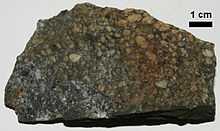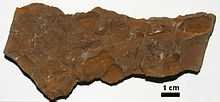Foreknobs Formation
| Foreknobs Formation Stratigraphic range: Late Devonian | |
|---|---|
 Conglomerate from Foreknobs Formation, Rt. 994, near western side of bridge going over Raystown Lake, Huntingdon County, Pennsylvania | |
| Type | sedimentary |
| Unit of | Greenland Gap Group |
| Sub-units | Mallow Member, Briery Gap Sandstone Member, Blizzard Member, Pound Sandstone Member, and Red Lick Member |
| Underlies | Catskill Formation, or Hampshire Formation in VA |
| Overlies | Scherr Formation, or Brallier Formation in VA |
| Thickness | 1321 ft at type section |
| Lithology | |
| Primary | siltstone, sandstone, conglomerate |
| Location | |
| Region | Appalachian Mountains |
| Extent | Pennsylvania, Maryland, Virginia, West Virginia |
| Type section | |
| Named for | Fore Knobs of Allegheny Front |
| Named by | J. M. Dennison, 1970 |
The Devonian Foreknobs Formation is a mapped bedrock unit in Pennsylvania, Maryland, Virginia, and West Virginia.
Description
The Foreknobs Formation contains massive sandstones; siltstone; "redbeds" of brownish-gray sandstone, siltstone, and shale containing scattered marine fossils; and occasional quartz-pebble conglomerate or conglomeratic sandstone beds.[1]
Stratigraphy
Dennison (1970) renamed the old Chemung Formation the Greenland Gap Group and divided it into the lower Scherr Formation and the upper Foreknobs Formation. De Witt (1974) extended the Scherr and Foreknobs into Pennsylvania, but did not use the term Greenland Gap Group.[2]
Boswell, et al. (1987), does not recognize the Scherr and Foreknobs Formations in the subsurface of West Virginia and thus these formations are reduced from "group" to "formation" as the Greenland Gap Formation.[3]
Rossbach and Dennison (1994) extended the Foreknobs into the Catawba syncline of southwestern Virginia.[4]
The Foreknobs is divided into the following Members, in ascending order: Mallow Member, Briery Gap Sandstone Member, Blizzard Member, Pound Sandstone Member, and Red Lick Member
Fossils

Red beds within the Foreknobs contain scattered marine fossils, such as brachiopods.
Notable Exposures
Type section: along WV Highway 42, 0.48 km northwest of Scherr, Grant County, West Virginia
Age
Relative age dating places the Foreknobs in the late Devonian.
References
- ↑ Dennison, J.M., 1970, Stratigraphic divisions of Upper Devonian Greenland Gap Group ("Chemung Formation") along Allegheny Front in West Virginia, Maryland, and Highland County, Virginia: Southeastern Geology, v. 12, no. 1, p. 53-82.
- ↑ de Witt, Wallace, Jr., 1974, Geologic map of the Beans Cove and Hyndman quadrangles and part of the Fairhope quadrangle, Bedford County, Pennsylvania: U.S. Geological Survey Miscellaneous Investigations Series Map, I-801, 6 p., 1 sheet, scale 1:24,000
- ↑ Boswell, R.M., Donaldson, A.C., and Lewis, J.S., 1987, Subsurface stratigraphy of the Upper Devonian and Lower Mississippian of northern West Virginia: Southeastern Geology, v. 28, no. 2, p. 105-131.
- ↑ Rossbach, T.J., and Dennison, J.M., 1994, Devonian strata of Catawba syncline, near Salem, Virginia, IN Schultz, Art, and Henika, Bill, Fieldguides to Southern Appalachian structure, stratigraphy, and engineering geology: Virginia Polytechnic Institute and State University, Department of Geological Sciences Guidebook, Geological Society of America, Southeastern Section, Annual Meeting, Blacksburg, VA, April 7–9, 1994, no. 10, p. 95-126.